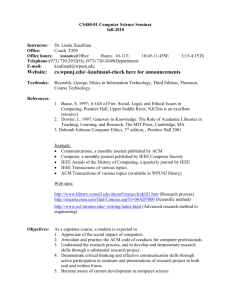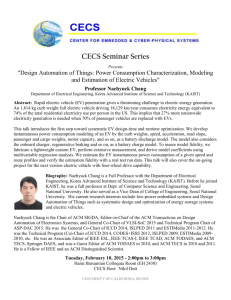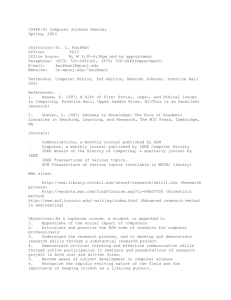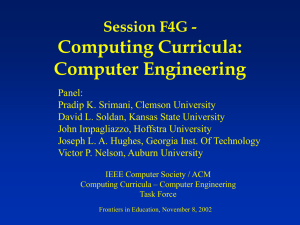JIIT FDP Sanjay Goel
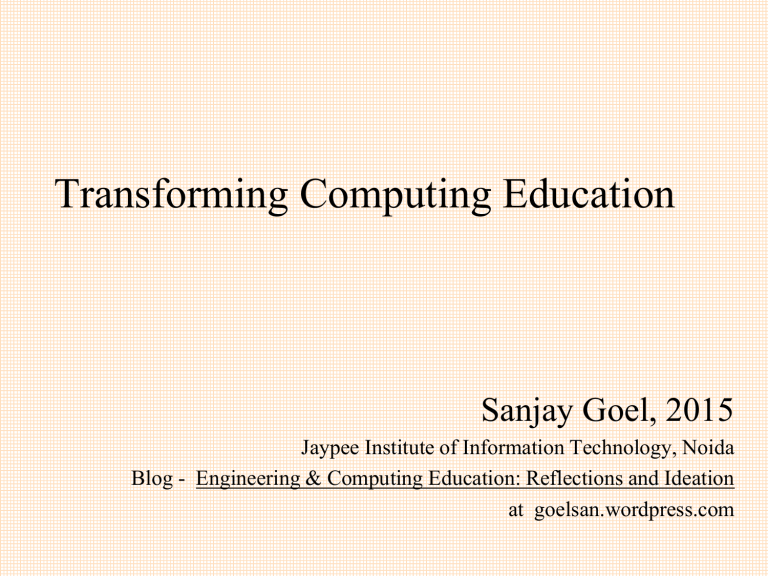
Transforming Computing Education
Sanjay Goel, 2015
Jaypee Institute of Information Technology, Noida
Blog - Engineering & Computing Education: Reflections and Ideation at goelsan.wordpress.com
Evolution of Computing Education Curriculum
• 65’ ACM curricula committee for CS
• 68’ ACM Curricula for CS (UG and PG)
• 68 COSINE’ IEEE for CS in EE
• 71 COSINE’ IEEE for CS in EE (UG)
• 72’ ACM curriculum on IS (UG)
• 73’ ACM curriculum on IS (PG)
• 75’ IEEE Model Curricula for CSE (UG)
• 77’ IEEE Model Curricula for CSE (UG)
• 78’ ACM Health Computing Curriculum (UG &PG)
• 78’ ACM Curricula for CS (UG)
• 81’ ACM Curricula for CS (PG)
• 82’ ACM curriculum on IS (UG and PG)
• 84’ IFIP curriculum for CS
• 85’ CMU curriculum for CS (UG)
• 86’ LACS Model Curriculum for CS (UG)
• 89’ ACM Computing as a discipline (UG &PG)
• 90’ SEI model curriculum for SE (UG)
• 91’ ACM/IEEE (UG and PG)
• 93’ IEEE paper, Model Indian currr. for CSE (UG)
• 94’ IFIP curriculum for CS (UG)
• 96’ LACS curriculum for CS (UG)
• 97’ ACM curriculum on IS (UG)
• 99’ SEI-CMU Software Engg Body of Knowledge
• 00’ IFIP curriculum for Informatics (UG)
• 00’ AICTE curriculum for CSE (UG)
• 00’ AICTE curriculum for IT (UG)
• 01’ ACMIEEE curriculum on computing
• 02’ ACM/AIS/AITP curriculum for IS
• 03’ K-12 Curriculum
• 04’ ACM-IEEE curriculum for SE
• 04’ ACM-IEEE curriculum for CE
• 04’ IEEE SWEBOK 2004
• 05’ ACM- IEEE curriculum for CS
• 05’ ACM-IEEE curriculum for IT
• 06’ ACM-AIS graduate curriculum -MSIS
• 07’ LACS curriculum for CS (UG)
• 08’ACM-IEEE curriculum for CS
• 08’ ACM-AIT curriculum for IT
• 09’ SEI GrSwE curriculum
• 10’ ACM-AIS curriculum for IS
• 10’ IEEE SWEBOK 2010
• 10’ SEI S/W assurance curr. (UG & PG)
• 11’ IEEE SWEBOK V 3 (in progress)
• 11’ ACM CSTA K-12
• 12’ NSF/IEEE Curr. on PDC (UG)
• 13’ ACM-IEEE curriculum for CS
Lecture in the Fresnes Prison
A University Class, 1350s
Let us reflect on the FDP So far
• What are the three most important facts/concepts that you have learnt so far?
Let us reflect on the FDP So far
• What are the three most important facts/concepts that you have learnt so far?
• So what?
Let us reflect on the FDP So far
• What are the three most important facts/concepts that you have learnt so far?
• So what?
• Has anything changed in your assumptions about your role as a CS teacher?
• If yes, what is the change in your assumptions? State your old and new assumptions?
Let us reflect on the FDP So far
• What are the three most important facts/concepts that you have learnt so far?
• So what?
• Has anything changed in your assumptions about your role as a CS teacher?
• If yes, what is the change in your assumptions? State your old and new assumptions?
• Now what? Do you intend to change something?
What and how?
• Does Engineering Education Have Anything to Do with Either
One?
• College teaching may be the only skilled profession for which no preparation or training is provided or required.
- Richard Felder
Professor Emeritus, Chemical Engg.,
North Carolina State University
• Teachers need to know more than just their subject. They need to know the ways it can come to be understood, the ways it can be misunderstood, what counts as understanding: they need to know how individuals experience the subject.
- Diana Laurillard, 1993
Professor of Learning with Digital Technologies,
University of London
NBA, India, 2013
Graduate Attributes of UG Engineering programs:
1 . Engineering knowledge: Apply the knowledge of mathematics, science, engineering fundamentals, and an engineering specialisation to the solution of complex engineering problems.
2. Problem analysis : Identify, formulate, research literature, and analyse complex engineering problems reaching substantiated conclusions using first principles of mathematics, natural sciences, and engineering sciences.
3. Design/development of solutions: Design solutions for complex engineering problems and design system components or processes that meet the specified needs with appropriate consideration for the public health and safety, and the cultural, societal, and environmental considerations.
4. Conduct investigations of complex problems: Use research-based knowledge and research methods including design of experiments, analysis and interpretation of data, and synthesis of the information to provide valid conclusions.
5. Modern tool usage: Create, select, and apply appropriate techniques, resources, and modern engineering and IT tools including prediction and modelling to complex engineering activities with an understanding of the limitations.
6. The engineer and society: Apply reasoning informed by the contextual knowledge to assess societal, health, safety, legal, and cultural issues and the consequent responsibilities relevant to the professional engineering practice.
7. Environment and sustainability: Understand the impact of the professional engineering solutions in societal and environmental contexts, and demonstrate the knowledge of, and need for sustainable development.
8 . Ethics: Apply ethical principles and commit to professional ethics and responsibilities and norms of the engineering practice.
9. Individual and Team work: Function effectively as an individual, and as a member or leader in diverse teams, and in multidisciplinary settings.
10. Communication: Communicate effectively on complex engineering activities with the engineering community and with society at large, such as, being able to comprehend and write effective reports and design documentation, make effective presentations, and give and receive clear instructions.
11. Project management and finance: Demonstrate knowledge and understanding of the engineering and management principles and apply these to one's own work, as a member and leader in a team, to manage projects and in multidisciplinary environments.
12. Life-long learning: Recognise the need for, and have the preparation and ability to engage in independent and lifelong learning in the broadest context of technological change.
India’s Ranks in Global Innovation Index, 2013
66
102
108
77
124
11
105
133
30
89
87
49
96
46
102
76
24
106
94
95
51
122
37
53
62
22
42
65
44
53
105
India’s Ranks in Global Innovation Index, 2014
76
31
106
120
83
128
96
128
122
31
87
93
50
99
33
106
80
41
59
93
110
46
100
50
57
87
24
66
82
78
94
58
Changing India,
WIPO, 2014
Specialisation Index
Education Vs Innovation
Bruce L. Gary (1993), A New Timescale For Placing Human Events, Derivation Of Per Capita Rate Of
Innovation, and a Speculation On The Timing of The Demise Of Humanity
NBA, India, 2013
Graduate Attributes of UG Engineering programs:
1 . Engineering knowledge: Apply the knowledge of mathematics, science, engineering fundamentals, and an engineering specialisation to the solution of complex engineering problems.
2. Problem analysis : Identify, formulate, research literature, and analyse complex engineering problems reaching substantiated conclusions using first principles of mathematics, natural sciences, and engineering sciences.
3. Design/development of solutions: Design solutions for complex engineering problems and design system components or processes that meet the specified needs with appropriate consideration for the public health and safety, and the cultural, societal, and environmental considerations.
4. Conduct investigations of complex problems: Use research-based knowledge and research methods including design of experiments, analysis and interpretation of data, and synthesis of the information to provide valid conclusions.
5. Modern tool usage: Create, select, and apply appropriate techniques, resources, and modern engineering and IT tools including prediction and modelling to complex engineering activities with an understanding of the limitations.
6. The engineer and society: Apply reasoning informed by the contextual knowledge to assess societal, health, safety, legal, and cultural issues and the consequent responsibilities relevant to the professional engineering practice.
7. Environment and sustainability: Understand the impact of the professional engineering solutions in societal and environmental contexts, and demonstrate the knowledge of, and need for sustainable development.
8 . Ethics: Apply ethical principles and commit to professional ethics and responsibilities and norms of the engineering practice.
9. Individual and Team work: Function effectively as an individual, and as a member or leader in diverse teams, and in multidisciplinary settings.
10. Communication: Communicate effectively on complex engineering activities with the engineering community and with society at large, such as, being able to comprehend and write effective reports and design documentation, make effective presentations, and give and receive clear instructions.
11. Project management and finance: Demonstrate knowledge and understanding of the engineering and management principles and apply these to one's own work, as a member and leader in a team, to manage projects and in multidisciplinary environments.
12. Life-long learning: Recognise the need for, and have the preparation and ability to engage in independent and lifelong learning in the broadest context of technological change.
Three-tier Taxonomy of Core Competencies for
Software Developers
Basic Competencies Competency Driver-
Habits of Mind
1. Technical competence 1. Attention to details
2. Computational thinking competence
2. Critical and reflective thinking
3. Domain competence
4. Communication competence
5. Complex problem solving competence
3. Creativity and innovation
Competency
Conditioning Attitudes and Perspectives
1. Curiosity
2. Decision perspective making
3. Systems-level perspective
4. Intrinsic motivation to create/improve artifacts
What is weak in our system?
1. Becoming actively interested in course content
2. Being alert to assessment requirements and criteria
3. Being aware of understanding development while learning
4. Checking evidence and relating it to conclusions
5. Examining logic and arguments cautiously and critically
6. Feeling undue pressure and worry about work
7. Finding difficulty in making sense of new ideas presented
8. Finding the right conditions and material for studying
9. Gearing work to the perceived preference of teachers
10. Intention – to achieve the highest possible grades
11. Intention – to cope with course requirements
12. Intention – to understand ideas for yourself
13. Looking for patterns and underlying principles
14. Managing time and effort effectively
15. Memorizing facts and carrying out procedures routinely
16. Monitoring the effectiveness of ways of studying
17. Putting consistent effort into studying
18. Relating ideas to previous knowledge and experience
19. Seeing little value or meaning in either course or tasks set
20. Studying without reflecting on either purpose or strategy
21. Treating the course as unrelated bits of knowledge
Please label these as attributes of
•
Surface,
•
Strategic,
•
Deep approaches to learning
1. Becoming actively interested in course content
2. Being alert to assessment requirements and criteria
3. Being aware of understanding development while learning
4. Checking evidence and relating it to conclusions
5. Examining logic and arguments cautiously and critically
6. Feeling undue pressure and worry about work
7. Finding difficulty in making sense of new ideas presented
8. Finding the right conditions and material for studying
9. Gearing work to the perceived preference of teachers
10. Intention – to achieve the highest possible grades
11. Intention – to cope with course requirements
12. Intention – to understand ideas for yourself
13. Looking for patterns and underlying principles
14. Managing time and effort effectively
15. Memorizing facts and carrying out procedures routinely
16. Monitoring the effectiveness of ways of studying
17. Putting consistent effort into studying
18. Relating ideas to previous knowledge and experience
19. Seeing little value or meaning in either course or tasks set
20. Studying without reflecting on either purpose or strategy
21. Treating the course as unrelated bits of knowledge
Attributes of
•
Surface,
•
Strategic,
•
Deep approaches to learning
1. Becoming actively interested in course content
2. Being alert to assessment requirements and criteria
3. Being aware of understanding development while learning
4. Checking evidence and relating it to conclusions
5. Examining logic and arguments cautiously and critically
6. Feeling undue pressure and worry about work
7. Finding difficulty in making sense of new ideas presented
8. Finding the right conditions and material for studying
9. Gearing work to the perceived preference of teachers
10. Intention – to achieve the highest possible grades
11. Intention – to cope with course requirements
12. Intention – to understand ideas for yourself
13. Looking for patterns and underlying principles
14. Managing time and effort effectively
15. Memorizing facts and carrying out procedures routinely
16. Monitoring the effectiveness of ways of studying
17. Putting consistent effort into studying
18. Relating ideas to previous knowledge and experience
19. Seeing little value or meaning in either course or tasks set
20. Studying without reflecting on either purpose or strategy
21. Treating the course as unrelated bits of knowledge
Attributes of
•
Surface,
•
Strategic,
•
Deep approaches to learning
What does the current system encourage and facilitate?
What do you want to encourage and facilitate?
Thanks
Sanjay Goel,
Jaypee Institute of Information Technology, Noida
Blog - Engineering & Computing Education: Reflections and Ideation at goelsan.wordpress.com

